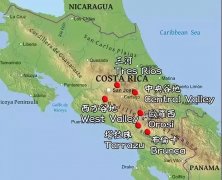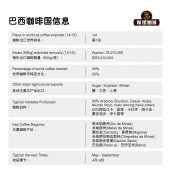Introduction to the treatment and grading of coffee beans in Brazil the taste and flavor characteristics of Huangbourne in Queen's Manor
When it comes to Brazilian coffee beans, many people don't seem to have much impression, but Brazil is actually a very important part of making espresso beans.
Brazilian coffee is the largest coffee producer and the most complete coffee production base in the world. it is slightly bitter and smooth in the fragrance. It is not only the largest coffee producer, but also the second largest coffee consumer. Today, the editor will give you a brief introduction to Brazilian coffee.

Let's start with the growing history of coffee beans in Brazil. The Brazilian coffee bean variety was introduced to Brazil from French Guiana in the 1720s. Francesco Paletta, a Portuguese captain from Brazil, captured the heart of the then governor's wife in Cayenne, the capital of French Guinea, and successfully brought coffee seeds to Brazil. Since then, coffee has adapted quickly in Brazil, spreading from the north to the southeastern state of Sao Paulo and the southern province of Parana, where it is at slightly higher latitudes and Frosts Descent in winter, resulting in heavy losses to farmers. From 1970 to 1980, Brazilian farmers developed the warmer provinces of Minas and Bahia in the northern state of Sao Paulo, which are less warm in winter than Frosts Descent until today Minas has become one of the main producing areas of Brazilian boutique coffee.
There are 26 states in Brazil, 17 states are growing coffee beans, and seven of them produce more coffee than the whole country by 98%. The seven states are:
State of Sao Paulo (Mogiana, Centro-Oeste)
State of Parana (Norte Pionerio do Paran á)
Bahia State (Planaltoda Bahia, Cerrado da Bahia, Atlantico Baiano)
Espiritu Santo (Montanhas do Esp í rito Santo, Conilon Capixaba)
Minas Gerais State (Sul de Minas, Cerrado Mineiro, Chapada de Minas, Matas de Minas)
Rond ô nia
Rio de Janeiro State (Rio de Janeiro)
There is a Brazilian bean from the Queen's Manor in the front street coffee. Fazenda Rainha (Queen Farm), owned by the prestigious coffee family CarvalhoDias family, is located in the Alta Mogiana area of Sao Paulo (Sao Paulo), north of the city of Sao Paulo. Carvalho Dias has four major estates since the first Brazilian COE Competition in 1999, has won awards every year, has won more than 12 awards in the past seven years, and even won the champion, 9th and 11th in 2004. 200 mu of yellow bourbon coffee trees are planted in the manor.
Here are the details of the Brazilian coffee country sorted out by Qianjie Coffee.

This yellow bourbon dry aroma of Qianjie coffee shows the aroma of roasted hazelnut and cinnamon, while the wet aroma is tropical fruit aroma, cream and sucrose.

There are four most common treatment methods for Brazilian coffee beans, namely, sun treatment, half-sun treatment, semi-washing treatment and water washing treatment, among which water washing treatment started in Brazil. Late, the market recognition is not high.
Characteristics of Brazilian coffee beans
Coffee beans have a strong aroma, moderate bitterness and high texture acidity. The overall taste is soft, low acidity and endless aftertaste.
The taste of Brazilian coffee has a low sour taste, with the sweet and bitter taste of coffee, the entrance is very smooth, but also with a hint of grass aroma, slightly bitter in the fragrance, smooth and smooth, with a pleasant aftertaste.
Flavor grades: from high to low, Strictly Soft is very supple, Soft is very supple, Softish is a little supple, Hardish is not palatable, Rioy iodine choking taste.
Classification of defect rate: according to the number of defective beans, 6 defective beans are NY.2 for every 300g raw beans. Completely flawless beans can become NY.1, while completely flawless beans are rare and unable to maintain a certain supply, so among the raw beans in Brazil, the best is NY.2.
Cup test quality classification: from high to low, Fine Cup, Fine, Good Cup, Fair Cup, Poor Cup, Bad Cup. FC (Fine Cup) and GC (Good Cup) are more common.
Particle size classification: in Brazil, the largest number of coffee beans is 19 mesh, but the yield is not much, so 17 mesh, 18 mesh is the highest grade.
Important Notice :
前街咖啡 FrontStreet Coffee has moved to new addredd:
FrontStreet Coffee Address: 315,Donghua East Road,GuangZhou
Tel:020 38364473
- Prev

Costa Rica Tala Beads Musicians Series Coffee Bean Taste Characteristics and Region Information Candle House
Costa Rican Coffee Costa Rican coffee has always been very stable flavor, drink soft balance. Sour, sweet and bitter, it is a classic coffee flavor. Costa Rica's coffee industry started very early, in 1729, coffee began to appear in Costa Rica, when it was introduced from Cuba. In 1820, the first shipments of coffee were made to Colombia and Chile. In 1832, local government
- Next

Introduction to the history and treatment of Brazilian coffee beans the flavor and taste of red bourbon coffee beans
Although Ethiopia is the country of origin of coffee, Brazil is currently the country with the largest coffee production and export in the world, and it has been going on for more than 100 years. In the 1820s, the output of new coffee even accounted for about 1/3 of the world's coffee production. Such a large output makes people curious about the information of Brazilian coffee. Coffee grown in Brazil
Related
- Detailed explanation of Jadeite planting Land in Panamanian Jadeite Manor introduction to the grading system of Jadeite competitive bidding, Red bid, Green bid and Rose Summer
- Story of Coffee planting in Brenka region of Costa Rica Stonehenge Manor anaerobic heavy honey treatment of flavor mouth
- What's on the barrel of Blue Mountain Coffee beans?
- Can American coffee also pull flowers? How to use hot American style to pull out a good-looking pattern?
- Can you make a cold extract with coffee beans? What is the right proportion for cold-extracted coffee formula?
- Indonesian PWN Gold Mandrine Coffee Origin Features Flavor How to Chong? Mandolin coffee is American.
- A brief introduction to the flavor characteristics of Brazilian yellow bourbon coffee beans
- What is the effect of different water quality on the flavor of cold-extracted coffee? What kind of water is best for brewing coffee?
- Why do you think of Rose Summer whenever you mention Panamanian coffee?
- Introduction to the characteristics of authentic blue mountain coffee bean producing areas? What is the CIB Coffee Authority in Jamaica?

